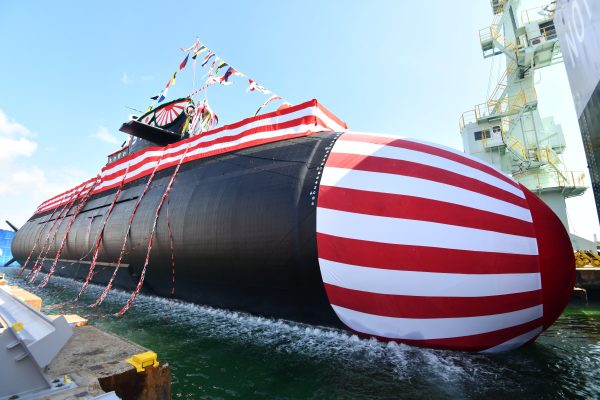
The Japan Maritime Self-Defense Force (JMSDF) commissioned the first of the new Taigei-class diesel-electric attack submarine (SSK) in a ceremony held on March 9 in Hyogo Prefecture in west-central Japan.
Named JS Taigei (with pennant number SS 513), the new boat was inducted into the Escort Division 4 of Escort Flotilla 2, which is homeported at the Yokosuka naval base in Kanagawa Prefecture, shortly after being handed over by shipbuilder Mitsubishi Heavy Industries (MHI) at its facility in Kobe City.
According to the JMSDF, the new submarine has a crew complement of about 70, an overall length of 84 m, a beam of 9.1 m, a draught of 10.4 m, and a standard displacement of about 3,000 tonnes, meaning that it is slightly larger than the well-known previous Soryu-class SSKs, which are 84 m long, 9.1 m wide, 10.3 m depth, and have a standard displacement of 2,950 tonnes.
Taigei means “big whale” in Japanese and was the name borne by a submarine tender in the Imperial Japanese Navy.
The new submarine, which cost about 80 billion yen ($690 million) to build, is powered by a diesel-electric engine generating 6,000 hp.
The JMSDF said that the new boat is equipped with lithium-ion batteries in place of lead-acid ones, just like the final two of 12 Soryu-class boats for the JMSDF: Oryu (SS 511) and Toryu (SS 512). Oryu was commissioned in March 2020 and Toryu entered service in March 2021.
GS Yuasa, a Kyoto-based developer and manufacturer of battery systems, provided the lithium-ion batteries for those new submarines.
The new Taigei-class will employ a “compact” and “highly efficient” electricity storage and supply system that will extend the submarine’s endurance under water without the need to increase the size of the boats, according to the Japanese Ministry of Defense (MoD).
The class will employ a new combat management system (CMS) combining advanced integrated sensors, command-and-control, and weapon engagement systems, the MoD said.
It will also adopt an enhanced snorkel system to reduce signatures, and a new-generation sonar system based on fiber-optic array technology to enhance detection capability.
The Taigei class will employ the same torpedo counter-measures system that has been incorporated into the last four Soryu-class boats. It is expected to use Japan’s newest torpedo, which is called the Type 18 and is expected to succeed the Type 89. Initially referred to as “G-RX6,” the new torpedo will feature improvements in a number of areas, including propulsion, target detection, and processing.
The class is also capable of deploying the UGM-84L Harpoon Block II anti-ship missile against surface targets. This missile range is 248 km – enough for Japan to acquire an “enemy base attack capability,” which has been still under hot debate in Tokyo.
The second Taigei-class submarine, named Hakugei (with pennant number SS 514), was launched by Kawasaki Heavy Industries (KHI) in October 2021 and is expected to enter service in March 2023. Hakugei means “white whale” in Japanese.
The MoD has allocated funds for the construction of four more submarines of the class – SS 515, SS 516, SS 517 and SS 518 – with MHI building the first, third, and fifth, and Kawasaki Heavy Industries (KHI) the second, fourth and sixth boats of the class.
Most recently, on December 24, 2021, the Japanese defense ministry was allocated 73.6 billion yen for fiscal year 2022 starting April to build the sixth boat of the class.
So far Japan is the only country known to have fitted lithium-ion batteries into SSKs, with South Korea expected to be the next country to do so.
Japan Commissions First New Taigei-Class Diesel-Electric Attack Submarine
Source: Frappler

0 Comments